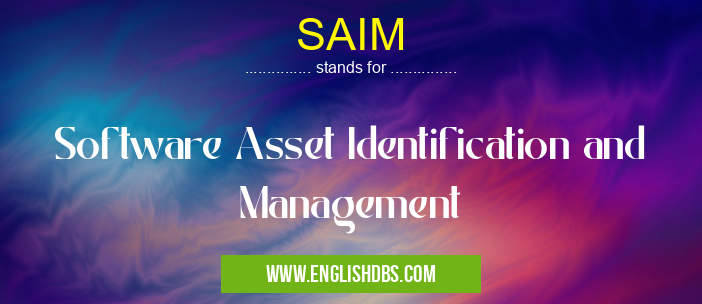What does SAIM mean in SOFTWARE
SAIM stands for Software Asset Identification and Management. It is a process that helps organizations to identify, track, and manage their software assets. This can include both on-premises software and cloud-based software. SAIM is important because it can help organizations to reduce their software costs, improve their software security, and better manage their software risks.

SAIM meaning in Software in Computing
SAIM mostly used in an acronym Software in Category Computing that means Software Asset Identification and Management
Shorthand: SAIM,
Full Form: Software Asset Identification and Management
For more information of "Software Asset Identification and Management", see the section below.
How does SAIM work?
SAIM typically involves the following steps:
- Discovery: Identifying all of the software assets that an organization owns or uses.
- Classification: Categorizing software assets by type, vendor, and other criteria.
- Tracking: Keeping track of software assets over time, including their installation, usage, and updates.
- Management: Managing software assets throughout their lifecycle, including procurement, deployment, and retirement.
Benefits of SAIM
There are many benefits to implementing a SAIM program. Some of the most notable benefits include:
- Reduced software costs: SAIM can help organizations to reduce their software costs by identifying and eliminating unnecessary software licenses.
- Improved software security: SAIM can help organizations to improve their software security by identifying and patching vulnerable software.
- Better managed software risks: SAIM can help organizations to better manage their software risks by providing them with a comprehensive view of their software assets.
- Improved software compliance: SAIM can help organizations to improve their software compliance by ensuring that they are using software in accordance with their licenses.
Essential Questions and Answers on Software Asset Identification and Management in "COMPUTING»SOFTWARE"
What is Software Asset Identification and Management (SAIM)?
SAIM is a process that involves identifying, tracking, and managing software assets throughout their lifecycle. It ensures that organizations have visibility into the software they own, use, and license.
Why is SAIM important?
SAIM is essential for organizations to:
- Control software costs and optimize licensing
- Ensure compliance with software licenses
- Manage software security risks
- Improve software utilization and efficiency
What are the key components of SAIM?
The key components of SAIM include:
- Asset identification and tracking
- License management
- Security management
- Software inventory and usage monitoring
What are the benefits of implementing SAIM?
The benefits of implementing SAIM include:
- Reduced software costs and increased licensing compliance
- Improved security posture
- Enhanced software utilization and efficiency
- Increased productivity and reduced downtime
How do I implement SAIM in my organization?
Implementing SAIM typically involves:
- Establishing a software asset inventory
- Implementing license management tools
- Establishing security controls
- Monitoring software usage and performance
Final Words: SAIM is a valuable tool that can help organizations to improve their software management practices. By implementing a SAIM program, organizations can reduce their software costs, improve their software security, and better manage their software risks.
SAIM also stands for: |
|
| All stands for SAIM |
